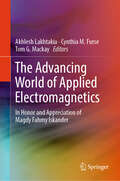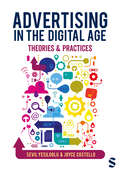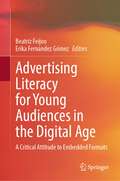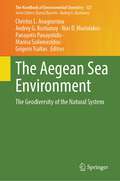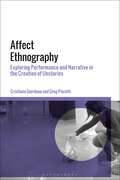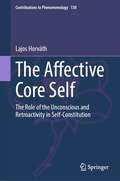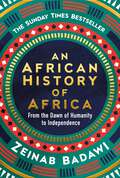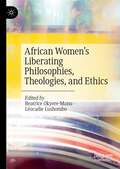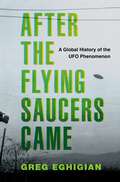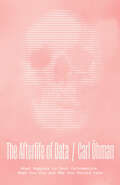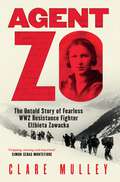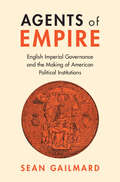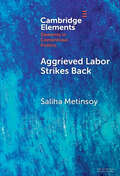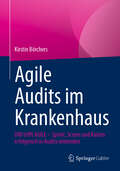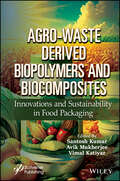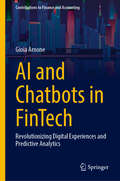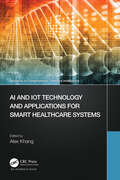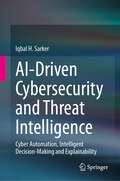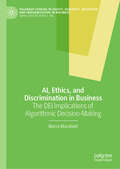- Table View
- List View
The Advancing World of Applied Electromagnetics: In Honor and Appreciation of Magdy Fahmy Iskander
by Akhlesh Lakhtakia Cynthia M. Furse Tom G. MackayThis book commemorates five decades of research by Professor Magdy F. Iskander (Life Fellow IEEE) on materials and devices for the radiation, propagation, scattering, and applications of electromagnetic waves, chiefly in the MHz-THz frequency range as well on electromagnetics education. This synopsis of electromagnetics, stemming from the life and times of just one person, is meant to inspire junior researchers and reinvigorate mid-level researchers in the electromagnetics community. The authors of this book are internationally known researchers, including 12 IEEE fellows, who highlight interesting research and new directions in theoretical, experimental, and applied electromagnetics.Provides a single-source reference to many of the most significant developments of the past 5 decades in theoretical, experimental, and applied electromagnetics;Offers readers in each sub-discipline discussed current research trends, the state of the art, the chief toolsneeded in that area, and the vision of a research leader for that area;Includes content of particular interest in Antennas and Propagation, as well as Microwave Theory and Techniques.
Advertising in the Digital Age: Theories and Practices
by Sevil Yesiloglu Joyce CostelloAdvertising is everywhere. Whether you realise it or not, it′s there when you watch your favourite Netflix show, when you scroll through Instagram, and when you search on Google. What′s more, advertisers are becoming more savvy than ever, using new technologies to target adverts to you specifically. So what are we to make of all this? This book will equip you with a thorough understanding of today′s media environment and how ′online′ advertising differs from traditional ′offline′ models. In an age of influencers, big data, AI and social media, the world of advertising looks very different from how it did a generation ago. You will learn not only about various types of advertising, but also about its impact on viewers, from our buying habits to possible harm. Tying theory and concepts to practice, this volume is the ideal complement to courses in advertising, digital media and communication, and will enable you to form a clear picture of the reality of working across promotional media industries.
Advertising in the Digital Age: Theories and Practices
by Sevil Yesiloglu Joyce CostelloAdvertising is everywhere. Whether you realise it or not, it′s there when you watch your favourite Netflix show, when you scroll through Instagram, and when you search on Google. What′s more, advertisers are becoming more savvy than ever, using new technologies to target adverts to you specifically. So what are we to make of all this? This book will equip you with a thorough understanding of today′s media environment and how ′online′ advertising differs from traditional ′offline′ models. In an age of influencers, big data, AI and social media, the world of advertising looks very different from how it did a generation ago. You will learn not only about various types of advertising, but also about its impact on viewers, from our buying habits to possible harm. Tying theory and concepts to practice, this volume is the ideal complement to courses in advertising, digital media and communication, and will enable you to form a clear picture of the reality of working across promotional media industries.
Advertising in the Digital Age: Theories and Practices
by Sevil Yesiloglu Joyce CostelloAdvertising is everywhere. Whether you realise it or not, it′s there when you watch your favourite Netflix show, when you scroll through Instagram, and when you search on Google. What′s more, advertisers are becoming more savvy than ever, using new technologies to target adverts to you specifically. So what are we to make of all this? This book will equip you with a thorough understanding of today′s media environment and how ′online′ advertising differs from traditional ′offline′ models. In an age of influencers, big data, AI and social media, the world of advertising looks very different from how it did a generation ago. You will learn not only about various types of advertising, but also about its impact on viewers, from our buying habits to possible harm. Tying theory and concepts to practice, this volume is the ideal complement to courses in advertising, digital media and communication, and will enable you to form a clear picture of the reality of working across promotional media industries.
Advertising Literacy for Young Audiences in the Digital Age: A Critical Attitude to Embedded Formats
by Beatriz Feijoo Erika Fernández GómezThis book analyzes how children and adolescents aged between 10 and 17 engage with digital advertising and highlights the importance of promoting advertising literacy to help young audiences recognize advertising and distinguish it from other media content in the digital age. As the advertising sector evolves, incorporating new formats like branded content and influencer marketing, the frontiers between commercial content and regular media become blurred, posing a challenge for children and adolescents to discern persuasive intent in advertising and distinguish advertising from other media content. In this context, it is crucial to assess children and adolescents’ preparedness to navigate digital advertising effectively by understanding their level of advertising literacy. With a higher level of advertising literacy, young audiences can evaluate advertisements, considering factors such as product appeal, presentation, and relevance to their experiences, as well as grasp thepurpose behind advertising and the techniques employed. This contributed volume brings together empirical studies and literature reviews to present an overview of the current research on advertising literacy among boys and girls aged between 10 and 17 in different countries to help educators, policymakers, advertisers, and society at large collaborate in nurturing responsible, informed, and ethically conscious digital citizens. Advertising Literacy for Young Audiences in the Digital Age: A Critical Attitude to Embedded Formats will be of interest to researchers working with media education, media sociology and childhood and adolescence studies. It will also help educators and policymakers develop better strategies to prepare children and adolescents to navigate digital advertising effectively.
The Aegean Sea Environment: The Geodiversity of the Natural System (The Handbook of Environmental Chemistry #127)
by Andrey G. Kostianoy Christos L. Anagnostou Ilias D. Mariolakos Panayotis Panayotidis Marina Soilemezidou Grigoris TsaltasThis is the first of three Books that together provide an integrated picture of the Aegean Sea, presenting the natural components of the system (Book I and Book II) as well as the human presence in the extended area (Book III). The Aegean Sea, also called Aegean Archipelagos, is an open, complex, and diverse marine system situated between the Black Sea and the Eastern Mediterranean, with different compartments and interactions. This book provides an in-depth exploration of the Aegean Sea's natural systems, shedding light on its geodiversity, geological dynamics, air-land-sea interaction, hydrology, suspended matter and sediments. Divided into 4 parts, the book introduces the diversity, geological dynamics, and evolution of the natural system of the Aegean Sea (Parts 1 and 2), followed by a section devoted to the land-sea interaction in the Aegean coastal system where experts in the field explore freshwater and matter inputs into the Aegean coastal system, as well as the coastal morphodynamics and evolution of the Aegean Sea, its adjacent land areas, and islands. In Part 3, the book delves into the air-sea interaction over the Aegean Sea, presenting its intricate dynamics, including heat and freshwater fluxes, wind waves, tides, and atmospheric deposition. The book closes with a section focused on the hydrology, chemistry, and dynamics of water masses and the sea bottom, providing insights into suspended matter and fluxes, sediments, climate changes, and the intricate nutrient and carbon dynamics within the Aegean Sea ecosystem (Part 4). Given the breadth and depth of its coverage, this book serves as a valuable resource for researchers, scholars, and students interested in marine geology, oceanography, and environmental analysis, as well as policymakers and conservationists seeking a comprehensive understanding of the Aegean Sea's complex natural systems.
Affect Ethnography: Exploring Performance and Narrative in the Creation of Unstories
by Dr Cristiana Giordano Dr Greg PierottiPlaying with the relation between truth and representation in the stories we tell as ethnographers and theater makers, this book contributes to the current debates around experimental research methodologies and ethnographically grounded theatrical forms. It departs from other studies by proposing a unique and accessible methodology that brings together theatrical devising practices and anthropology. Through its theoretical exploration and performative script, the book bridges the relation between ethnographic writing and performativity, and simultaneously troubles conventional narrative practices in theater and anthropology. The practice described in the book, Affect Theater, also emphasizes embodied and affective approaches to empirical research and defines a process for rendering this type of material into imaginative academic writing, collaborative performance, and other inventive forms, applicable across a range of academic disciplines.
The Affective Core Self: The Role of the Unconscious and Retroactivity in Self-Constitution (Contributions to Phenomenology #130)
by Lajos HorváthThis book extends the contemporary concept of the minimal self by introducing the affective core self. The overall aim is to integrate certain psychoanalytical ideas into the phenomenological investigation of passivity and reformulate the idea of the phenomenological unconscious. This volume contributes to the multidimensional analysis of the self by positioning the affective core self between the layers of the more minimal and the less minimal self. It underscores the importance of the unconscious in the constitution of the affective core self by providing the comparative analysis of the phenomenological and the psychoanalytical unconscious.Furthermore, comparisons are drawn between Freud’s conception of the afterwardsness of trauma and the phenomenological notion of retroactive sense-constitution. The book concludes that retroactive sense-making is a double-sided phenomenon and differentiates between implicit-bodily and conscious-narrative retroactive sense-constitution. In order to bolster the idea of implicit-bodily sense-constitution the volume also examines and utilizes contemporary insights on the nature of body memory. The conclusion claims that the affective core self is constituted in time by means of the underlying processes of the two-sided retroactive sense-constitution. This text appeals to students and researchers working in phenomenology and philosophy of mind.
Afghanistan 2001-2021: Gewaltideologien und ein Hauch von offener Gesellschaft (Globaler lokaler Islam)
by Abbas PoyaWelchen Einfluss haben Gesinnungen der Gewalt auf die gesellschaftlichen Entwicklungen in Afghanistan? Die internationalen Beiträger*innen richten ihren Blick auf linke, dschihadistische sowie talibanistische Ideologien und Praktiken in der jüngeren afghanischen Geschichte. Multiperspektivisch zeichnen sie den Verlauf der letzten 20 Jahre nach und fokussieren dabei vor allem auf den dramatischen Wandel, den die afghanische Bevölkerung in Bezug auf Kultur, Frauenrechte und Medien durchlebt: Einstige Sehnsüchte und die Hoffnung auf eine offene Gesellschaft verwandeln sich durch ein Wiedererstarken der Taliban in Alpträume.
An African History of Africa: From the Dawn of Humanity to Independence
by Zeinab BadawiA RADIO 4 BOOK OF THE WEEK *Selected as a book to look out for in 2024 by the Guardian and The Rest is Politics*Everyone is originally from Africa, and this book is therefore for everyone.For too long, Africa’s history has been dominated by western narratives of slavery and colonialism, or simply ignored. Now, Zeinab Badawi sets the record straight.In this fascinating book, Badawi guides us through Africa’s spectacular history – from the very origins of our species, through ancient civilisations and medieval empires with remarkable queens and kings, to the miseries of conquest and the elation of independence. Visiting more than thirty African countries to interview countless historians, anthropologists, archaeologists and local storytellers, she unearths buried histories from across the continent and gives Africa its rightful place in our global story.The result is a gripping new account of Africa: an epic, sweeping history of the oldest inhabited continent on the planet, told through the voices of Africans themselves.
African Women’s Liberating Philosophies, Theologies, and Ethics
by Beatrice Okyere-Manu Léocadie LushomboThis volume explores the ethical and philosophical paradigms presented by most of the influential Matriarchs of the Circle of African Women Theologians. It critically evaluates the effectiveness of their ethical and philosophical theories, models, and frameworks in pursuing justice and liberation for women in Africa and globally. The authors address critical questions: How have African women theologians reimagined existing ethical paradigms? What original ethical and philosophical ideas have they generated? How have their ethical frameworks influenced the theologies and interpretations they have developed? What purposes do their ethical and philosophical paradigms serve? How do these renderings intersect with various social categories, including gender, race, class, sexuality, capitalism, and colonialism? What liberating frameworks do they propose? The volume further explores the dialogue between distinct African contexts and universal experiences and values. It explores how universal themes such as humanity, human dignity, rights, justice, motherhood, and more can coexist with communal African concepts and themes. It contemplates how embracing African approaches engages these themes more globally, bringing together particular African contexts of women and the universal ethical, philosophical, and theological theories, models, and frameworks to advance the cause of justice and liberation for African women and women worldwide into the future.
After the Flying Saucers Came: A Global History of the UFO Phenomenon
by Greg EghigianRoswell, 1947. Washington, DC, 1952. Quarouble, 1954. New Hampshire, 1961. Pascagoula, 1973. Petrozavodsk, 1977. Copley Woods, 1983. Explore how sightings of UFOs and aliens seized the world's attention and discover what the fascination with flying saucers and extraterrestrial visitors says about our changing views on science, technology, and the paranormal. In the summer of 1947, a private pilot flying over the state of Washington saw what he described as several pie pan-shaped aircraft traveling in formation at remarkably high speed. Within days, journalists began referring to the objects as "flying saucers." Over the course of that summer, Americans reported seeing them in the skies overhead. News quickly spread, and within a few years, flying saucers were being spotted across the world. The question on everyone's mind was, what were they? Some new super weapon in the Cold War? Strange weather patterns? Optical illusions? Or perhaps it was all a case of mass hysteria? Some, however, concluded they could only be one thing: spacecrafts built and piloted by extraterrestrials. The age of the unidentified flying object, the UFO, had arrived. Greg Eghigian tells the story of the world's fascination with UFOs and the prospect that they were the work of visitors from outer space. While accounts of great wonders in the sky date back to antiquity, reports of UFOs took place against the unique backdrop of the Cold War and space age, giving rise to disputed government inquiries, breathtaking news stories, and single-minded sleuths. After the Flying Saucers Came traces how a seemingly isolated incident sparked an international drama involving shady figures, questionable evidence, suspicions of conspiracy, hoaxes, new religions, scandals, unsettling alien encounters, debunkers, and celebrities. It examines how descriptions, theories, and debates about unidentified flying objects and alien abduction changed over time and how they appeared in the United States, Europe, Latin America, Asia, and Russia. And it explores the impact UFOs have had on our understanding of space, science, technology, and ourselves up through the present day. Replete with stories of the people who have made up the ufology community, the military and defense units that investigate them, the scientists and psychologists who have researched these unexplained encounters, and the many novels, movies, TV shows, and websites that have explored these phenomena, After the Flying Saucers Came speaks to believers and skeptics alike.
The Afterlife of Data: What Happens to Your Information When You Die and Why You Should Care
by Carl ÖhmanA short, thought-provoking book about what happens to our online identities after we die. These days, so much of our lives takes place online—but what about our afterlives? Thanks to the digital trails that we leave behind, our identities can now be reconstructed after our death. In fact, AI technology is already enabling us to “interact” with the departed. Sooner than we think, the dead will outnumber the living on Facebook. In this thought-provoking book, Carl Öhman explores the increasingly urgent question of what we should do with all this data and whether our digital afterlives are really our own—and if not, who should have the right to decide what happens to our data. The stakes could hardly be higher. In the next thirty years alone, about two billion people will die. Those of us who remain will inherit the digital remains of an entire generation of humanity—the first digital citizens. Whoever ends up controlling these archives will also effectively control future access to our collective digital past, and this power will have vast political consequences. The fate of our digital remains should be of concern to everyone—past, present, and future. Rising to these challenges, Öhman explains, will require a collective reshaping of our economic and technical systems to reflect more than just the monetary value of digital remains. As we stand before a period of deep civilizational change, The Afterlife of Data will be an essential guide to understanding why and how we as a human race must gain control of our collective digital past—before it is too late.
The Afterlife of Data: What Happens to Your Information When You Die and Why You Should Care
by Carl ÖhmanA short, thought-provoking book about what happens to our online identities after we die. These days, so much of our lives takes place online—but what about our afterlives? Thanks to the digital trails that we leave behind, our identities can now be reconstructed after our death. In fact, AI technology is already enabling us to “interact” with the departed. Sooner than we think, the dead will outnumber the living on Facebook. In this thought-provoking book, Carl Öhman explores the increasingly urgent question of what we should do with all this data and whether our digital afterlives are really our own—and if not, who should have the right to decide what happens to our data. The stakes could hardly be higher. In the next thirty years alone, about two billion people will die. Those of us who remain will inherit the digital remains of an entire generation of humanity—the first digital citizens. Whoever ends up controlling these archives will also effectively control future access to our collective digital past, and this power will have vast political consequences. The fate of our digital remains should be of concern to everyone—past, present, and future. Rising to these challenges, Öhman explains, will require a collective reshaping of our economic and technical systems to reflect more than just the monetary value of digital remains. As we stand before a period of deep civilizational change, The Afterlife of Data will be an essential guide to understanding why and how we as a human race must gain control of our collective digital past—before it is too late.
Agent Zo: The Untold Story of Fearless WW2 Resistance Fighter Elzbieta Zawacka
by Clare Mulley'Deeply researched and written with verve... thoughtful as well as action packed' The Times'Gripping, moving and important' Simon Sebag Montefiore'Clare Mulley tells the tale of the remarkable Elzbieta Zawacka with flare, passion and insight' James Holland'Agent Zo is a triumph. Absolutely essential reading' Hallie RubenholdThis is the incredible story of Elzbieta Zawacka, the WW2 female resistance fighter known as Agent Zo, told here for the very first time. Agent Zo was the only woman to reach London from Warsaw during the Second World War as an emissary of the Polish Home Army command, and then in Britain she became the only woman to join the Polish elite Special Forces, known as the 'Silent Unseen'. She was secretly trained in the British countryside, and then the only female member of these SOE affiliated forces to be parachuted back behind enemy lines to Nazi-occupied Poland. There, whilst being hunted by the Gestapo who arrested her entire family, she took a leading role in the Warsaw Uprising and the liberation of Poland.After the war she was demobbed as one of the most highly decorated women in Polish history. Yet the Soviet-backed post-war Communist regime not only imprisoned her, but also ensured that her remarkable story remained hidden for over forty years. Now, through new archival research and exclusive interviews with people who knew and fought alongside Zo, Clare Mulley brings this forgotten heroine back to life, and also transforms how we see the history of women's agency in the Second World War.
Agents of Empire: English Imperial Governance and the Making of American Political Institutions (Political Economy of Institutions and Decisions)
by null Sean GailmardTo understand the foundations of American political institutions, it's necessary to understand the rationale for British colonial institutions that survived the empire. Political institutions in England's American colonies were neither direct imports from England, nor home-grown creations of autonomous colonists. Instead, they emerged from efforts of the English Crown to assert control over their colonies amid limited English state and military capacity. Agents of Empire explores the strategic dilemmas facing a constrained crown in its attempts to assert control. The study argues that colonial institutions emerged from the crown's management of authority delegated to agents-first companies and proprietors establishing colonies; then imperial officials governing the polities they created. The institutions remaining from these strategic dynamics form the building blocks of federalism, legislative power, separation of powers, judicial review, and other institutions that comprise the American polity today.
Aggrieved Labor Strikes Back: Inter-sectoral Labor Mobility, Conditionality, and Unrest under IMF Programs (Elements in Contentious Politics)
by null Saliha MetinsoyWhy do we see large-scale labor protests and strikes under some IMF programs such as in Greece in 2010 and not in others such as in Ireland in the same year? This Element argues that extensive labor market reform conditions in an immobile labor market generate strong opposition to programs. Labor market reform conditions that decentralize and open up an immobile labor market cause workers either to lose in terms of rights and benefits, while being stuck in the same job or to fall into a less protected sector with fewer benefits. Conversely, in more mobile labor markets, wage and benefit differentials are low, and movement across sectors is easier. In such markets, labor groups do not mobilize to the same extent to block programs. The author tests this theory in a global sample and explores the causal mechanism in four case studies on Greece, Ireland, Latvia, and Portugal.
Agile Audits im Krankenhaus: DIN trifft AGILE - Sprint, Scrum und Kaizen erfolgreich in Audits einbinden
by Kirstin BörchersAudits im Krankenhaus werden oft noch sehr dokumentenlastig und auf ISO-Konformitätsprüfung ausgerichtet durchgeführt. Dabei geht es in Zeiten von E-Health, Digitalisierung und künstlicher Intelligenz (KI) im Krankenhaus längst um mehr und es ist vor allem eine flexiblere Herangehensweise gefordert. Die aktuellen Transformationsprozesse benötigen schnellere und dynamischere Anpassungen in der Organisation und bei den Abläufen. Mit Hilfe von agilen Audit-Instrumenten wie Scrum, Kaizen und Kanban können diese Herausforderungen gemeistert werden.Dieses Buch stellt nach einer Einführung in die Grundlagen von Audits die wichtigsten agilen Werte, Praktiken und Methoden vor, erläutert ihren möglichen Einsatz im Rahmen des allgemeinen Auditprozesses wie auch in den sogenannten „Audits im Sprint“. Agilität im Qualitätsmanagement und in der Durchführung interner Audits steht nicht im Widerspruch zum Leitfaden ISO 19011 „Auditierung von Managementsystemen“, in dem es um dieWirksamkeit und Eignung des QM-Systems sowie dessen Chancen zur Weiterentwicklung geht – sie ist vielmehr eine konsequente Weiterentwicklung. Best-Practice-Beispiele veranschaulichen, wie eine konkrete Umsetzung im Krankenhausumfeld aussehen kann.
Agro-Waste Derived Biopolymers and Biocomposites: Innovations and Sustainability in Food Packaging
by Santosh Kumar Avik Mukherjee Vimal KatiyarAGRO-WASTE DERIVED BIOPOLYMERS AND BIOCOMPOSITES This comprehensive book describes the fundamental principles and major advancements in the utilization of agro-waste for deriving biopolymers, and their applications to fabricate composite, nanocomposite, and hybrid food packaging films and coatings. The book serves as a complete, systematic, comprehensive account of the contemporary developments in the area of novel and environment-friendly valorization of agro- and food wastes into value-added products like biodegradable polymer and active functional agents for food packaging applications. It also describes the hurdles and challenges in the commercialization of these novel biopolymer-based materials, including their composites, their applications, safety, and legal ramifications. This book consists of fifteen chapters covering different aspects of agro- and food waste utilization, the development of biodegradable polymers, and their composites for sustainable food packaging applications. The first thirteen chapters detail the processing of various agro- and food wastes of plant and animal origin to synthesize different biopolymers, such as starch, cellulose, chitosan, silk proteins, pectin, etc., and their applications for the fabrication of sustainable food packaging materials and composites that are attractive alternatives to synthetic plastic packaging. These chapters also summarize the effectiveness of these biopolymers and their composites in developing active films and edible coatings for shelf-life extension and preservation of perishable foods. A chapter is devoted to issues of biodegradability, including analyses of various biodegradation reactions, such as depolymerization, mineralization, biochemical, and abiotic degradation both in soil and aquatic environments. The book concludes with a chapter addressing the concerns associated with the possible migration of components or additives from these biodegradable packaging into packaged food items. Audience The primary audience for this book is researchers, scientists, and engineers working in food science and technology, food engineering and technology, food biotechnology, sustainable food packaging, etc. Additionally, food entrepreneurs and associated businesses, such as the packaging and coatings industries, will also have a keen interest in the book.
Agro-Waste Derived Biopolymers and Biocomposites: Innovations and Sustainability in Food Packaging
by Santosh Kumar Avik Mukherjee Vimal KatiyarAGRO-WASTE DERIVED BIOPOLYMERS AND BIOCOMPOSITES This comprehensive book describes the fundamental principles and major advancements in the utilization of agro-waste for deriving biopolymers, and their applications to fabricate composite, nanocomposite, and hybrid food packaging films and coatings. The book serves as a complete, systematic, comprehensive account of the contemporary developments in the area of novel and environment-friendly valorization of agro- and food wastes into value-added products like biodegradable polymer and active functional agents for food packaging applications. It also describes the hurdles and challenges in the commercialization of these novel biopolymer-based materials, including their composites, their applications, safety, and legal ramifications. This book consists of fifteen chapters covering different aspects of agro- and food waste utilization, the development of biodegradable polymers, and their composites for sustainable food packaging applications. The first thirteen chapters detail the processing of various agro- and food wastes of plant and animal origin to synthesize different biopolymers, such as starch, cellulose, chitosan, silk proteins, pectin, etc., and their applications for the fabrication of sustainable food packaging materials and composites that are attractive alternatives to synthetic plastic packaging. These chapters also summarize the effectiveness of these biopolymers and their composites in developing active films and edible coatings for shelf-life extension and preservation of perishable foods. A chapter is devoted to issues of biodegradability, including analyses of various biodegradation reactions, such as depolymerization, mineralization, biochemical, and abiotic degradation both in soil and aquatic environments. The book concludes with a chapter addressing the concerns associated with the possible migration of components or additives from these biodegradable packaging into packaged food items. Audience The primary audience for this book is researchers, scientists, and engineers working in food science and technology, food engineering and technology, food biotechnology, sustainable food packaging, etc. Additionally, food entrepreneurs and associated businesses, such as the packaging and coatings industries, will also have a keen interest in the book.
AI and Chatbots in Fintech: Revolutionizing Digital Experiences and Predictive Analytics (Contributions to Finance and Accounting)
by Gioia ArnoneThis book is a comprehensive guide to the use of Artificial Intelligence (AI) in the Financial Technology (FinTech) industry. It is comprised of ten chapters, each addressing a specific aspect of AI in FinTech. The reader is introduced to AI in FinTech, including its history and current state and the role of chatbots in FinTech and how they are used to improve customer service. Furthermore, the book explores the business framework of AI-based ChatGPT in FinTech, including the technology behind ChatGPT and how it can be applied to various financial sectors. The book examines the use of predictive analytics and machine learning in FinTech, highlighting how these tools are used to predict customer behavior and improve decision-making. The author delves into how ChatGPT is used to determine buying behavior and discusses the use of machine learning to reshape the digital experience in FinTech. Additionally, the book provides best practices for retaining customers in FinTech, including how to use AI to create personalized experiences that keep customers coming back, and explores the different applications of predictive models in FinTech, including how they are used to improve risk management and fraud detection. Lastly, the book discusses the use of ChatGPT for stock price prediction and the detection of financial fraud and examines the role of ChatGPT in the world of cryptocurrency, including how it can be used to make informed investment decisions. Overall, this book provides a comprehensive overview of the different ways AI is being used in FinTech and the potential it holds for improving customer experiences and driving innovation in the financial industry.
AI and IoT Technology and Applications for Smart Healthcare Systems (Advances in Computational Collective Intelligence)
In recent years, the application of Artificial Intelligence (AI) and Internet of Things (IoT) technologies in smart healthcare has been increasing. We are approaching a world where connected smart devices tell people when they need to visit a doctor because these devices will be able to detect health problems and discover symptoms of illness that may need medical care. AI-collaborative IoT technologies can help medical professionals with decision-making. These technologies can also help develop a sustainable and smart healthcare system.AI and IoT Technology and Applications for Smart Healthcare Systems helps readers understand complex scientific topics in a simple and accessible way. It introduces the world of AI-collaborative IoT physics, explaining how this technology behaves at the smallest level and how this can revolutionize healthcare. The book shows how IoT technology and AI can work together to make computers more powerful and capable of solving complex problems in the healthcare sector. Exploring the effect of AI-collaborative technology on IoT technologies, the book discusses how IoT can benefit from AI algorithms to enable machines to learn, make decisions, and process information more efficiently. Because smart machines create more perceptive devices and systems, the application of this technology raises important ethical questions about privacy, security, and the responsible development of healthcare IoT technology, which this book covers. The book also provides insight into the potential applications of these technologies not only in the healthcare industry but also in related fields, such as smart transportation, smart manufacturing, and smart cities.
AI and IoT Technology and Applications for Smart Healthcare Systems (Advances in Computational Collective Intelligence)
by Alex KhangIn recent years, the application of Artificial Intelligence (AI) and Internet of Things (IoT) technologies in smart healthcare has been increasing. We are approaching a world where connected smart devices tell people when they need to visit a doctor because these devices will be able to detect health problems and discover symptoms of illness that may need medical care. AI-collaborative IoT technologies can help medical professionals with decision-making. These technologies can also help develop a sustainable and smart healthcare system.AI and IoT Technology and Applications for Smart Healthcare Systems helps readers understand complex scientific topics in a simple and accessible way. It introduces the world of AI-collaborative IoT physics, explaining how this technology behaves at the smallest level and how this can revolutionize healthcare. The book shows how IoT technology and AI can work together to make computers more powerful and capable of solving complex problems in the healthcare sector. Exploring the effect of AI-collaborative technology on IoT technologies, the book discusses how IoT can benefit from AI algorithms to enable machines to learn, make decisions, and process information more efficiently. Because smart machines create more perceptive devices and systems, the application of this technology raises important ethical questions about privacy, security, and the responsible development of healthcare IoT technology, which this book covers. The book also provides insight into the potential applications of these technologies not only in the healthcare industry but also in related fields, such as smart transportation, smart manufacturing, and smart cities.
AI-Driven Cybersecurity and Threat Intelligence: Cyber Automation, Intelligent Decision-Making and Explainability
by Iqbal H. SarkerThis book explores the dynamics of how AI (Artificial Intelligence) technology intersects with cybersecurity challenges and threat intelligence as they evolve. Integrating AI into cybersecurity not only offers enhanced defense mechanisms, but this book introduces a paradigm shift illustrating how one conceptualize, detect and mitigate cyber threats. An in-depth exploration of AI-driven solutions is presented, including machine learning algorithms, data science modeling, generative AI modeling, threat intelligence frameworks and Explainable AI (XAI) models. As a roadmap or comprehensive guide to leveraging AI/XAI to defend digital ecosystems against evolving cyber threats, this book provides insights, modeling, real-world applications and research issues. Throughout this journey, the authors discover innovation, challenges, and opportunities. It provides a holistic perspective on the transformative role of AI in securing the digital world.Overall, the useof AI can transform the way one detects, responds and defends against threats, by enabling proactive threat detection, rapid response and adaptive defense mechanisms. AI-driven cybersecurity systems excel at analyzing vast datasets rapidly, identifying patterns that indicate malicious activities, detecting threats in real time as well as conducting predictive analytics for proactive solution. Moreover, AI enhances the ability to detect anomalies, predict potential threats, and respond swiftly, preventing risks from escalated. As cyber threats become increasingly diverse and relentless, incorporating AI/XAI into cybersecurity is not just a choice, but a necessity for improving resilience and staying ahead of ever-changing threats. This book targets advanced-level students in computer science as a secondary textbook. Researchers and industry professionals working in various areas, such as Cyber AI, Explainable and Responsible AI, Human-AI Collaboration, Automation and Intelligent Systems, Adaptive and Robust Security Systems, Cybersecurity Data Science and Data-Driven Decision Making will also find this book useful as reference book.
